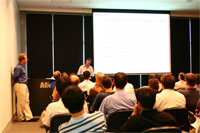| SSW Update - Do you conduct a Specification Review? |

[ the cutting edge ]G'Day Developers! What is the step that the client should undertake after an initial meeting? We think it should be a "Specification Review". Generally a client wants to know if his idea will be $50K or $150K. A "Specification Review" is performed to determine the overall scope, feasibility, and ballpark of the project. We encourage you to also create a detailed "Release Plan" for the first 2 releases. eg. Mr Northwind learns that the idea he presented at the initial meeting will cost approximately $80K and he has to determine if that is feasible to his business or if he should remove some functionality. The Specification Review should be paid work and is conducted by two experienced developers at the client premises in close consultation with the client. The time allocated for a Spec Review is generally 1 - 5 days depending on initial expectations of the project. The rule of thumb is 1 - 2 days Spec Review per estimated month of project time. The purpose is to understand the whole project but, if the project is greater than six months, focus primarily on the first six months. The Spec Review is a process that will demonstrate to the client whether you have the commercial sense to understand their **business** and have the technical and management capacity to complete the project. Talk Business Process
Do something valuable Most experts at software consulting will be able to provide a small improvement to the current system 'on the fly' during the Spec Review. This may be something as simple as adding an index to a table and thereby increasing the performance of a webpage. See the further steps we take.Cheers until next time,
Adam Got a comment for Adam? 6164616d636f67616e407373772e636f6d2e6175 |
||
Sydney .NET User Group -
|

|
2 days to go!
Sydney .NET User Group |
We work efficiently on the right things in a visible way…. Looking at processes and tracking and time systems
Every IT development group gets criticised by its customers (internal and external) for not getting their priorities right and not being open about what they are actually doing. If your group all worked as efficiently as possible, on precisely the things that your customer wanted in the right priority order in such a visible way that your customer could change priority and know all the impacts, it would be virtually impossible for the customer to be critical. While it's probably impossible to develop and execute all the processes to achieve this, we can get very close and have a lot of fun and pride doing so.
This talk is all about having all tracking and development information in one integrated system that does not include email. Emails should not contain information that needs to be referenced and should not be used for discussion; it is a good medium for reminders but anything useful in them should be moved to the integrated system. From one end of the spectrum a business stakeholder (customer) should be able to view the work in progress starting from a high level e.g. drilling down into a programme and see any amount of detail they wish. Similarly, a developer should be able to view what they are working on and then link up to the associated requirements and programme giving the reason for each task. Every bit of time worked by anybody should also be recorded on the system for both accounting and historical reasons. These figures can then be used for changing strategy (e.g. spend more on support and less on development) and for helping future estimates and planning.
Having tried a variety of open source, commercial and home-grown systems, the presenter has chosen a combination of Jira and Confluence (both provided by Atlassian) and SVN. While these products are not the only solution, they demonstrate how well the processes of an organisation can be modelled and tracked. We are not talking bug tracking here, we are talking about tracking everything everybody needs and does. Each member of the company has a personal dashboard showing them their work outstanding together with priorities, dependencies, time estimates and due dates.
Mark Hetherington is the CTO of Tilefile. He graduated from London University with an honours degree
In Computer Science and nine years with a
UK software house before moving to Australia. Mark helped found the Australian Centre for Unisys
Software (ACUS) and then became its director during
which time he grew the organization to over 150 while managing other software groups in New Zealand
and the United States.
In 1994, he joined his first Internet startup which went on to build the successful RSVP dating
business. He grew this company to over one hundred
staff before moving on. In 1999, he moved to Seattle to be responsible for building the first airborne
Internet server which sent the first email from a plane less than a
year later while growing the company from 18 to over 100.
After launching his own award-winning (Consensus Software Award) Internet service in 2003, he spent a
year in Vancouver rescuing a poor-performing
gaming software organization by introducing good process and helping move the share price from a few
cents to over $3. He was the CIO of Mooter Media from 2005 to 2007 where he built the software
organization and deployed the application to dozens of servers in
China where it served over 200 million individually selected advert impressions per day.
His expertise lies in software engineering process, operational process, high throughput web systems,
system architecture & staff management.
He joined Tilefile in May 2007 where his vast experience has admirably complimented the young,
talented and creative engineering team.
Canberra Developers .NET User Group -
The best place to learn .NET for free in Canberra

|
3 days to go!
Canberra .NET Developers User Group |
ASP.NET MVC Preview 2 Presented by Tatham Oddie
What is this whole MVC thing anyway? Hot on the heels of MIX08 and last week’s release of ASP.NET MVC Preview 2, Tatham Oddie will demonstrate how to use the model-view-controller (MVC) pattern to take advantage of your favourite .NET Framework language for writing business logic in a way that is de-coupled from the views of the data. We’ll discuss the advantages to MVC on the web, the other frameworks that are available, and build an app with it - all in 45 minutes.
Internet Explorer 8 for Developers Presented by Tatham Oddie
The release of Internet Explorer 8 Beta 1 demonstrates some exciting new technologies for developers. These technologies are open standards, and implementations are already being worked on in the Firefox and Safari camps too. In 20 minutes we’ll do a lap of activities, WebSlices and the new debugging tools.
See You There!!! | Sorry I can't make it
BI Voyage class -
Microsoft BI Bootcamp: SQL Server 2005, Office System 2007 and PerformancePoint Server 2007

|
*Special 10% Off*
SQL Server 2005 End-to-End Business Intelligence Workshop |
Description
Business intelligence solutions provide the infrastructure that enables people at all levels of a business to make better decisions based on more accurate and up-to-date information. This workshop focuses on the teaching IT professionals the best practices and skills required to successfully design, build, deploy, and operate a business intelligence solution using SQL Server 2005.
Course Summary
During this 5-day course, you will learn about integrating Integration Services, Analysis Services and Reporting Services to build a business intelligence solution. When you complete this course, you will understand how to design, develop, deploy, and operate a business intelligence solution that integrates data from an On-Line Transactional Processing (OLTP) into a SQL Server Analysis Services (SSAS) cube and delivers reports to business users.
- Integrate: Define, debug, deploy, manage and secure SQL Server Integration
Services (SSIS) packages that extract, transform, and load
data from an OLTP database into an SSAS cube and a relational data warehouse
- Analyze: Define, deploy, process, manage and secure SQL Server Analysis Services
(SSAS) cubes, mining models, dimensions, hierarchies,
calculations, translations, and Key Performance Indicators (KPIs)
- Report: Define, deploy, manage, and secure SQL Server Reporting Services (SSRS) reports that consume data stored in SSAS cubes and in the relational data warehouse and deliver reports to business users.
This course will demonstrate a fully working end-to-end solution, including extensive demos, hands-on labs, sample projects that will not only teach how to use the new technology, but also illustrate business intelligence and data warehouse best practices.
See more about the SSW Special on this BI Course.
Featured Product: SSW Code Auditor
 Automate your Code Reviews with SSW Code
Auditor
Automate your Code Reviews with SSW Code
Auditor
Are you looking to eradicate bugs and ensure consistency? SSW Code Auditor is a tool that allows developers to take control of your code, ensuring large, complex source code can be simplified, cleaned and maintained. The built-in rules focus on the most popular .NET languages (C#, VB.NET) for both Windows Forms and ASP.NET; however, the flexibility of SSW Code Auditor allows the developer to add their own rules to target any language in any text file.
As a project or company grows, managing code standards throughout your team becomes virtually impossible. Consistent code is crucial to future development and maintenance. SSW Code Auditor lets you take control of your code and automatically review your web apps and projects - giving you more opportunity to spend time where it really matters.
Advertise with SSW
If you would like to advertise your product or service with
SSW or would like to find out more about various advertising
opportunities, please email your enquiry to
736f7068696562656c6c65407373772e636f6d2e6175
or call: +61 2 9953 3000.

March 2008 |
||||||||
Tech Breakfast
February was a big month for Microsoft, lots of releases and updates
Find out what’s new and how it affects you
Now that SQL 2008 is almost upon us and you have finally moved to SQL 2005. Are you really using all of the 2005 features? Come see Justin King demonstrate the T-SQL Language enhancements such as PIVOT, Common Table Expressions (CTE), Ranking Functions, Exception Handling, DDL Triggers and much more. Also see how you can build CLR assemblies and how to use them within SQL Server 2005 and new features in SQL Server 2008.
Streamline your project management and development cycles with Project Server 2007. In this session we will be stepping into the roles of the Project Manager, Developer, Account Manager and Client to see how these roles interact within a project. We will integrate with Microsoft Team Foundation Server 2008 and the Project Server 2007 Outlook Add-in Features covered
|
||||||||
TipsWindows ASP/ASP.NET |
||||||||
EmploymentDue to the tremendous growth that our business has experienced over the last few months, we are seeking enthusiastic people to join the SSW team. Our Company is based in Neutral Bay which is one of the most elegant and scenic areas of Sydney. SSW is an Australian owned progressive consulting firm specialising in building, implementing and maintaining Microsoft .NET software applications. We are currently strongly looking for a Technical BDM to take initial meetings and manage clients in Brisbane, Melbourne, or Canberra. We are also currently looking for:
|
